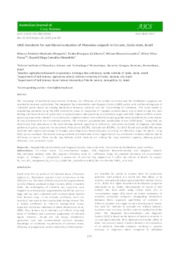DRIS standards for nutritional evaluation of Phaseolus vulgaris in Cerrado, Goiás State, Brazil.
DRIS standards for nutritional evaluation of Phaseolus vulgaris in Cerrado, Goiás State, Brazil.
Author(s): MESQUITA, M. A. M; SILVEIRA, P. M. da; LEANDRO, W. M.; FLORES, R. A.; MARANHÃO, D. D. C.
Summary: The knowledge of nutritional requirements of beans, the efficiency of soil acidity correction and the fertilization programs are essential to increase productivity. The Integrated Recommendation and Diagnosis System (DRIS) assists with nutritional diagnosis of cultivated plants based on existing interactions between nutrients and the hierarchizing of limitations. This study aimed at establishing standards using the DRIS method for areas of production of irrigated common beans and at determining the most limiting nutritional factors to production using leaf analyses interpreted by concentration ranges and DRIS. Eighteen different beanproducing areas were selected in a central pivot irrigation system, from which 82 sampling points were established to collect leaves of crop and determine their nutritional contents. The reference population had productivity of over 3,000 kg ha- 1. Using DRIS, we determined that phosphorus is the most limiting nutrient regarding its deficiency, with great sensitivity to diagnose nutritional problems of plants, especially micronutrients. Phosphorus (68.3%), molybdenum (65.9%), iron (64.6 %) and sodium (63.4%) and are nutrients with highest percentage of samples presenting levels below adequate according to sufficiency ranges for plants. Using DRIS, we can evaluate interactions among nutrients and determine of the magnitude of crop nutritional limitation whether due to deficiency or excess. These results may indicate which nutrients are limiting the crop productive capacity, allowing greater efficiency in its correction in soil.
Publication year: 2018
Types of publication: Journal article
Unit: Embrapa Rice & Beans
Keywords: Análise Foliar, Beans, DRIS, Feijão, Leaf area, Nutrição Vegetal, Plant micronutrients
Observation
Some of Embrapa's publications are published as ePub files. To read them, use or download one of the following free software options to your computer or mobile device. Android: Google Play Books; IOS: iBooks; Windows and Linux: Calibre.
Access other publications
Access the Agricultural Research Database (BDPA) to consult Embrapa's full library collection and records.
Visit Embrapa Bookstore to purchase books and other publications sold by Embrapa.

